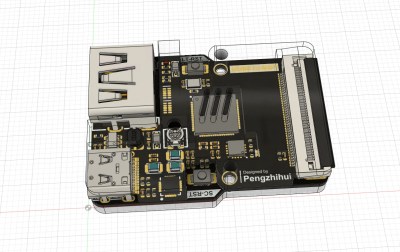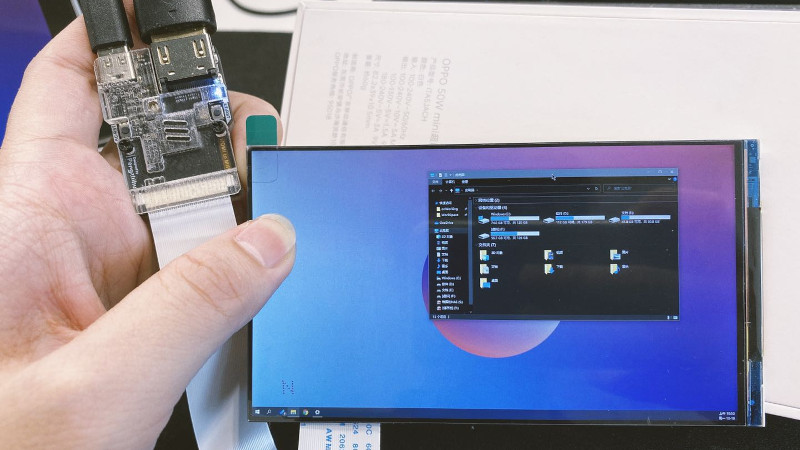Compared to most small LCDs sold to makers, smartphone screens boast excellent color, brightness, and insanely high resolution. Unfortunately, driving them is rarely straightforward. In an attempt to make it easier, [peng-zhihui] set about developing tools to allow such screens to be driven from a simple HDMI feed. For those whose Chinese is a little rusty, the Google Translate link might prove useful.
The first attempt was using Toshiba’s TC358870XBG ASIC, capable of driving screens over MIPI DSI 1.1 from an HDMI input. [peng-zhihui] designed a simple test module for the chip based on the company’s evaluation board design, with [ylj2000] providing software to help get that solution off the ground.
 However, for now that solution is imperfect, so [peng-zhihui] also experimented with the Longxun LT6911 HDMI to MIPI driver. While cheap, information on the part is scarce, and the company’s own source code for using the hardware is only accessible by signing an NDA. However, [peng-zhihui] made pre-compiled firmware available for those that wish to work with the hardware.
However, for now that solution is imperfect, so [peng-zhihui] also experimented with the Longxun LT6911 HDMI to MIPI driver. While cheap, information on the part is scarce, and the company’s own source code for using the hardware is only accessible by signing an NDA. However, [peng-zhihui] made pre-compiled firmware available for those that wish to work with the hardware.
[peng-zhihui] has put these learnings to good use, building a power bank with a MIPI screen using what appears to be the Longxun chip. The device can supply power over USB and also act as an HDMI display.
While it’s early days yet, and driving these screens remain difficult, it’s great to see hackers getting out there and finding a way to make new parts work for them. We’ve seen similar work before, using an FPGA rather than an off-the-shelf ASIC. If you’ve found your own way to get these high-end displays working, be sure to drop us a line!
[Thanks to peterburk for the tip!]















cool – could use this as UV PCB exposer ; look forward to further developments
But… the pixels don’t block UV.
Oh they do. Didn’t you notice all the MSLA resin printers out there?
This. I actually bought this 6″, 2K display (MIPI) meant as a replacement screen for resin 3D printers, but used it as a secondary monitor for my PC.
Dope
Good job, [peng-zhihui] and shame on everyone involved with making this as difficult as it is. Right to repair laws need to crack down on these secretive “NDA to use” cases.
China has a particular sort of relationship economy around technical documentation that’s unfamiliar to westerners; Bunnie Huang coined the term ‘gongkai’ for it several years ago: https://www.bunniestudios.com/blog/?p=4297
Well, then your comment should be up there also, with racism. Culture is culture, and culture is not often a bad thing
In this case it really is the very definition of a bad thing.
It has nothing to do with Racism. The fact is the culture in China openly encourages technology theft with zero regard to IP rights. Anything goes when it comes to catching up to the most advanced countries but at what cost? Such theft kills innovation because why would you invest large amounts of money into developing something that the someone will just steal and mass produce at a fraction of the cost, killing your business?
Sorry, but that’s nonsense and you don’t really understand at all what that “gongkai” term is about. It has nothing to do with corruption, cronyism or favoritism. It is sort of “unwritten code” of behavior that companies there follow and use it to obtain and share information that would be otherwise impossible to get.
Here in the West that same information is locked up behind NDAs, patent walls (both HDMI and MIPI), mandatory licensing, with an individual developer or a small company having pretty much zero chance to build a product that would be legal to sell with these technologies due to the expenses involved.
And for a hobbyist the only recourse is either to reverse engineer things or to resort to the various Chinese language forums where the information is available because of the “gongkai” system …
So be careful about throwing stones in the glasshouse. We are not any better here.
It is not just those NDAs. Those are really the least of your problems.
MIPI specs are not publicly available to begin with, you must be a member of MIPI to get them ($$$).
Same with HDMI – you must be a member and pay the fees, e.g. Analog Devices won’t sell you any parts that work with HDMI unless you are HDMI licensee. They used to sell at least the parts without the HDCP keys programmed in but even those are not available anymore.
Yay for the patent hell that is modern electronics (and not only).
Not saying this is the case, but many times NDAs are used when they may not have the rights to share information with you. The NDA is legal recourse if you tell anyone they’re doing something that might be a violation of someone else’s licenses or copyrights.
Not having rights to share basic information needed for use or interoperability is exactly the kind of situation that shouldn’t be tolerated.
I found this because I bought an HDMI capture module for the Raspberry Pi Nano that uses the TC358743XBG chip that converts HDMI to CSI.
I searched for the chip, saw similar parts for HDMI-DSI on Toshiba’s website, and searched for those.
Back in 2014 I saw a similar article here on Hackaday about driving an iPhone 4S screen from an FPGA. But the board is huge, the power consumption is significant, and it can’t exactly bring a Raspberry Pi into my pocket.
The PocketLCD could change that.
I’ve tried to find part numbers for the BOMs so that I can order these from JLCPCB or PCBWay. If someone could double-check, that would be wonderful!
Also, if anybody’s willing to help design an adaptor for the iPhone 4 LCD connector from the footprint in twlostow/dsi-shield so that I can connect it to the HDMI-PI, that would be wonderful – that’s my plan eventually!
Feel free to reach out by email; I’m interested in chatting to anybody else who wants to get a small run of these manufactured for personal use.
PocketLCD:
https://pastebin.com/Hqj8DCNc
HDMI-PI:
https://pastebin.com/YFX0wPLq
Your comment is awaiting moderation.
I found this because I bought an HDMI capture module for the Raspberry Pi Zero that uses the TC358743XBG chip that converts HDMI to CSI.
I searched for the chip, saw similar parts for HDMI-DSI on Toshiba’s website, and searched for those.
Back in 2014 I saw a similar article here on Hackaday about driving an iPhone 4S screen from an FPGA. But the board is huge, the power consumption is significant, and it can’t exactly bring a Raspberry Pi into my pocket.
The PocketLCD could change that.
I’ve tried to find part numbers for the BOMs so that I can order these from JLCPCB or PCBWay. If someone could double-check, that would be wonderful!
Also, if anybody’s willing to help design an adaptor for the iPhone 4 LCD connector from the footprint in twlostow/dsi-shield so that I can connect it to the HDMI-PI, that would be wonderful – that’s my plan eventually!
Feel free to reach out by email; I’m interested in chatting to anybody else who wants to get a small run of these manufactured for personal use.
I too am interested in this stuff having collected a few working smartphone screens over time (for me, Sony to start with).
I am too well aware of the problems with these datasheets, having worked over the years with Japanese and Korean manufacturers supplying chips to the mobile phone industry, they are paranoid about secrecy and datasheets are usually under NDA.
Reading through the google-translated version of the site there are a few references to “warehouse” as in “仓库”, I think this really means “repository”, i.e. github.
Would love to see cell phone screen based display products that are easy to connect to a Raspberry Pi
For those projects where want to deploy the Pi-based packaged system to where uses very minimal physical dimension space, but still drives the full on HDMI display from the Pi
“learnings”
That word one of my disappointings with the evolution of the English language.
That word IS one of….
Dammit.
Tee hee!
What about this one https://hackaday.io/project/364/logs ?